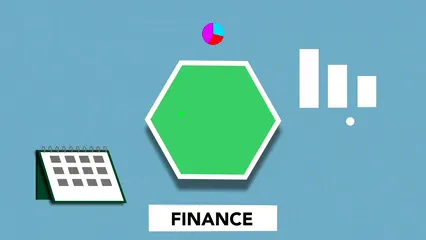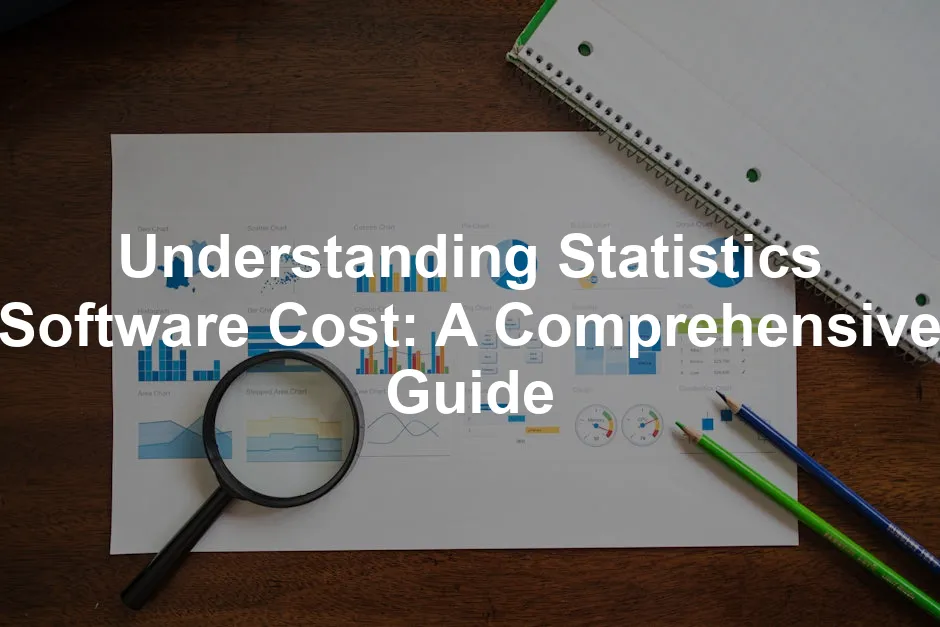Introduction
Statistical software plays a crucial role in data analysis. It helps organizations make sense of vast amounts of data. However, costs for this software can vary widely. Factors like features, licensing models, and user needs all contribute to these differences. This article aims to give you a detailed overview of the costs associated with various statistical software options.
Summary and Overview
Several key factors influence statistics software costs. First, features and capabilities directly impact pricing. More advanced tools often come with higher fees. Next, it’s essential to choose software that aligns with your budget and requirements.
Pricing models can also differ. Some software follows a subscription model, while others offer perpetual licenses. Academic pricing is another option, providing discounts for students and educators. Popular statistics software options include IBM SPSS, Minitab, R, Python, and JMP, each with varying price ranges to accommodate different user needs.

For a deeper understanding of statistical software options, check out this guide on an introduction to statistical learning with Python.
Factors Influencing Statistics Software Cost
1.1 Features and Capabilities
Advanced features can greatly affect the cost of statistical software. For instance, tools that offer machine learning or sophisticated data visualization capabilities often come at a premium. Additionally, functionalities such as statistical tests or data preparation options can also drive up pricing. If you seek comprehensive analysis tools, be prepared for higher costs compared to basic offerings.
1.2 Licensing Models
When it comes to statistics software, licensing models play a huge role in costs. The two primary models are subscription and perpetual licenses.
Subscription licenses require ongoing payments, usually monthly or annually. This option offers flexibility and lower upfront costs. However, over time, these payments can add up. If you stay with the software long-term, a subscription can become expensive.
On the other hand, perpetual licenses involve a one-time payment. This means you own the software indefinitely. While the initial cost is higher, you won’t have recurring fees. If you plan to use the software for years, this option often proves more economical.
Consider your usage and budget carefully. Choosing the right model can save you money in the long run.
1.3 User Type and Needs
Costs for statistics software vary significantly based on user type. Individuals, businesses, and academic institutions all face different pricing structures.
Individuals typically choose entry-level software, which can range from free to around $300 per year. These options usually come with fewer features but can meet basic analysis needs.
Businesses often need more advanced tools. Prices can start at $1,524 per user per year for subscriptions. Larger companies may invest in bulk licenses, which can offer savings.
Academic institutions benefit from special pricing. Many software providers offer discounts for students and educators. For example, IBM SPSS provides a GradPack for students, making advanced tools accessible for under $100.
Understanding your user type and specific needs helps in selecting the most cost-effective software.

2.3 SAS and Stata
SAS and Stata cater to professionals who need robust statistical analysis tools. SAS is known for its extensive data handling capabilities, making it popular among large organizations and industries like healthcare. Stata, however, attracts researchers and academics with its user-friendly interface and strong programming language.
When it comes to pricing, SAS can be on the higher end. Typical costs start at around $8,700 for a yearly license. Stata offers a more budget-friendly option, with prices starting around $840 annually. While SAS provides advanced analytics and data management features, Stata excels in ease of use and accessibility for smaller teams or individuals.
In comparing functionality versus cost, SAS offers a comprehensive suite of tools, but at a premium price. Conversely, Stata provides substantial capabilities for data analysis without the hefty price tag, making it a great value for users focused on statistical methods.
2.4 Minitab and JMP
Minitab and JMP are popular choices among professionals seeking user-friendly statistical software. Minitab is renowned for its focus on Six Sigma and quality improvement. It includes tools for regression, ANOVA, and control charts, making it ideal for manufacturing and quality control. If you’re diving into Six Sigma, consider investing in Minitab for a smoother journey.
JMP, developed by SAS, stands out with its interactive data visualization features. It allows users to explore data through dynamic graphics and offers extensive statistical capabilities. Both programs cater to a mix of academic and professional users, though their focuses differ.
In terms of cost, Minitab’s pricing begins at around $1,780 per year, while JMP typically starts at about $1,200 annually. Minitab’s comprehensive features justify its price, especially for Six Sigma applications. JMP, with its emphasis on data visualization, provides excellent value for users who prioritize exploration and presentation of complex data sets.

Cost-Benefit Analysis of Statistics Software
3.1 Evaluating Return on Investment (ROI)
Assessing the ROI of investing in statistical software is crucial for making informed decisions. Start by considering how the software can improve efficiency and accuracy in your analyses. For instance, a company that integrates Minitab into its quality control process may see a significant reduction in errors, leading to cost savings.
Another example includes academic institutions that adopt IBM SPSS for research. The insights gained can lead to groundbreaking findings, justifying the initial investment. When calculating ROI, factor in not just the purchase price, but also potential revenue increases, reduced labor costs, and enhanced decision-making capabilities.

3.2 Long-Term vs. Short-Term Costs
Understanding the long-term costs of statistical software is essential. Subscription models, while lower initially, can accumulate high expenses over time. For example, paying $99 monthly for software like IBM SPSS may seem manageable. However, over three years, that amounts to nearly $3,600.
In contrast, a one-time purchase may be pricier upfront, but it often saves money in the long run. Consider how often feature upgrades or renewals could affect your budget. Choosing perpetual licenses can prevent unexpected costs and provide stability for your financial planning. Balancing immediate needs with future budgeting is key to making the right choice.
Pricing Strategies for Different User Groups
4.1 Academic Pricing
Academic pricing is a fantastic way to make statistical software accessible. Many companies offer special discounts for students and educators. For instance, IBM SPSS provides an affordable GradPack for students, often costing under $100. This package includes essential features tailored for academic use. Additionally, the Faculty Pack allows educators to access comprehensive tools at a reduced rate. Universities can benefit from site-wide licenses, ensuring all students and staff have access to the software.

4.2 Business Packages
Businesses can enjoy significant benefits through bulk purchasing. Many software providers offer discounted rates for multiple licenses. This can lead to considerable savings, especially for larger teams. Companies often need customized solutions that fit their specific needs. Many providers, like JMP and Minitab, allow for tailored packages. These packages can include additional features and services, ensuring a perfect fit for the organization. Customization options enhance functionality, making it easier for teams to analyze data efficiently.

4.3 Free Trials and Freemium Models
Free trials are an excellent way to test software before committing. Many companies offer limited-time trials to help users assess functionality and usability. For example, IBM SPSS provides a free trial, allowing potential buyers to explore its features. This hands-on experience can significantly influence purchasing decisions. Some platforms adopt freemium models, offering basic features for free while charging for advanced options. However, these free versions often have limitations, such as restricted functionality or data capacity. Users should evaluate their needs to determine if the premium version is worth the investment.
Trends Influencing Statistics Software Costs
5.1 The Rise of Cloud-Based Solutions
Cloud computing is changing the way we think about software pricing. With cloud-based solutions, users can access tools without hefty upfront costs. This model often involves subscription fees, which can be more manageable. Popular cloud-based statistical tools include SAS Viya and Tableau. Their pricing structures are typically tiered, allowing users to pay for only what they need. This flexibility enhances accessibility for both individuals and organizations, making data analysis more affordable than ever.

5.2 Increasing Demand for Data Science Tools
The data analytics market is booming. More businesses are recognizing the power of data. This surge in demand is driving up the cost of statistics software. As companies seek to harness data effectively, competition among software providers intensifies.
With many players in the market, providers strive to offer better features at competitive prices. This competition can lead to favorable pricing for consumers. However, it also means that high-quality tools may come with a higher price tag. The growing interest in data science tools is shaping both the market and pricing dynamics.
5.3 Integration and Compatibility Costs
Costs can escalate when you need additional tools or integrations. Many software solutions require complementary tools to function optimally. For instance, IBM SPSS often pairs well with data visualization tools to enhance analysis. Similarly, Minitab users might need Excel for data manipulation, which can add to overall expenses.
These integration needs can create hidden costs. It’s crucial to consider not just the software price, but also the costs of necessary add-ons. Evaluating these factors will help in making a more informed decision about your investment in statistics software.

Conclusion
In summary, understanding the costs of statistics software involves considering various factors. The increasing demand for data science tools influences pricing, while integration needs can lead to additional expenses. Evaluating both cost and functionality is essential when selecting the right software.
Before making a decision, assess your unique needs and budget. This approach ensures you choose software that fits your requirements without overspending. Take the time to explore all options available to you.
Please let us know what you think about our content by leaving a comment down below!
Thank you for reading till here 🙂
All images from Pexels




